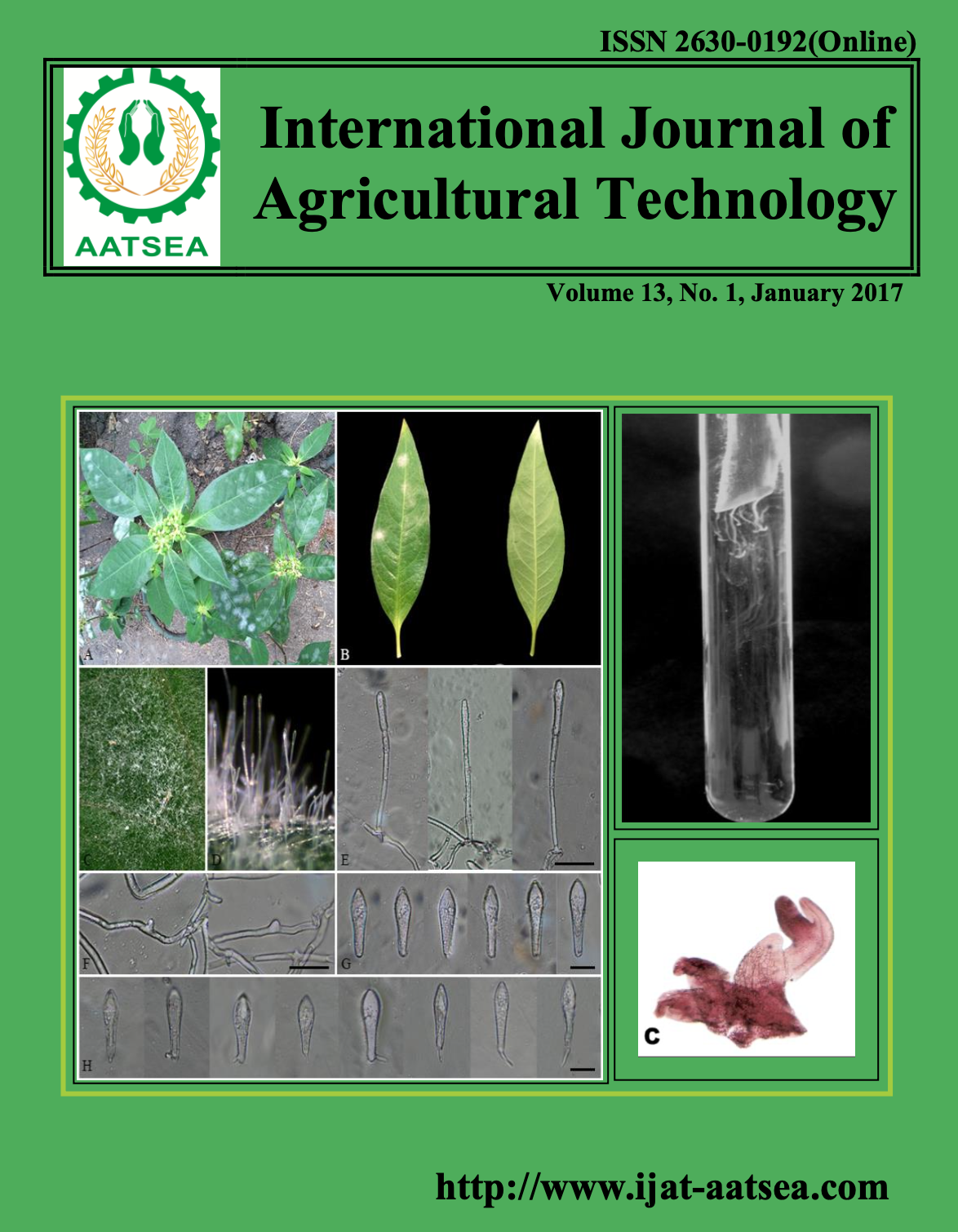Biocontrol of virulent Ralstonia solanacearum isolates by an indigenous Bacillus cereus
Main Article Content
Abstract
Article Details

This work is licensed under a Creative Commons Attribution-NonCommercial-NoDerivatives 4.0 International License.
References
Adhikari, T. B. and Basnyat, R. C. (1998). Effect of crop rotation and cultivar resistance on bacterial wilt of tomato in Nepal. Canadian Journal of Plant Pathology 20: 283-287.
Ausubel, F. M., Brent, R., Kingston, R. E., Moore, D. D., Seidman, J. G., Smith, J, A. and Struhl, K. (1992). Current protocols in molecular biology, v.1. Greene Publishing Association, New York.
Boudazin, G., Leroux, A. C., Josi, K., Labarre, P. and Jouan, B. (1999). Design of divisions specific primars of Ralstonia solanacearum and application to the identification of European isolate. European Journal of Plant Pathology 105:373-380.
Chandrashekara, K. N., Prasanna Kumar, M. K. and Saroja, S. (2012). Aggressiveness of Ralstonia solanacearum isolates on tomato. Journal of Experimental Sciences 3: 5-9.
Chen, Y., Yan, F., Chai, Y., Liu, H., Kolter, R., Losick, R. and Guo, J. H. (2013). Biocontrol of tomato wilt disease by Bacillus subtilis isolates from natural environments depends on conserved genes mediating biofilm formation. Environmental Microbiology 15:848-864.
Ciampi, L., Burzio, L. O. and Burzio, L. A. (1997). Carriers for Pseudomonas (Ralstonia) solanacearum, causal agent of bacterial wilt. Fitopathologia 32:64-70.
Dhingra, O. D. and Sinclair, J. B. (1995). Basic Plant Pathology Methods, 2nd ed. CRC Press, London.
Dubey, L. N., Das, K. K. and Hazarika, D. K. (1996). Evaluation of some chemicals against bacterial wilt of Sesamum. Journal of Mycological Plant Pathology. 26:94-95.
Elphinstone, J., Hennessy, J., Wilson, J. and Stead, D. E. (1996). Sensitivity of different methods for the detection of Pseudomonus solanacearum (Smith) Smith in potato tuber extracts. EPPO Bulletin 26:663-678.
Fouche-Weich, J., Poussier, S., Trigalet-Demery, D., Berger, D. and Coutinho, T. (2006). Molecular identification of some African strains of Ralstonia solanacearum from eucalypt and potato. Journal of General Plant Pathology 72:369-373.
Grimault, V., Schmit, J. and Prior, P. (1993). Some characteristics involved in bacterial wilt (Pseudomonas solanacearum) resistance in tomato. In: Hartman GL, Hayward (eds). Bacterial wilt. ACIAR Proceedings 112-119.
Hayward, A. C. (1991). Biology and epidemiology of bacterial wilt, caused by Ralstonia solanacearum. Annu. Rev. Phytopathol 29: 65-87.
Hernandez-Romano, J., Ramirez-Rojas, S. and Ydrac-Morales, C, J. (2012). First report of Ralstonia solanacearum causing tomato bacterial wilt in Mexico. New Disease Reports 26:22.
Hoque, M. E. and Mansfield, J. W. (2005). A sample and reliable method for pathogenicity tests of bacterial blight disease of rice. Bangladesh Journal of Botany 34:11-16.
Kisore, V., Shekhawat, G. S. and Sunaina, V. (1996). Cultural practices to reduce Pseudomonas solanacearum in the infested soil. Journal of Indian Potato. 23:130-133.
Leppla, N., Momol, T., Nesheim, N. and Dusky, J. (2004). Plant, animal and human protection, FAS 2 Focus Area. University of Florida / IFAS. Available at: http://edis.ifas.ufl.edu/.
Lwin, M. and Ranamukhaarachchi, S. L. (2006). Development of biological control of Ralstonia solanacearum through antagonistic microbial populations. International Journal of Agriculture Biology 5:657-660.
Maji, S. and Chakrabartty, P. K. (2014). Biocontrol of bacterial wilt of tomato caused by Ralstonia solanacearum by isolates of plant growth promoting rhizobacteria. Australian Journal of Crop Science 8:208-214.
Manjula, K. and Podile, A. R. (2005). Increase in seedling emergence and dry weight of pigeon pea in the field with chitin-supplemented formulations of Bacillus subtilis AF1. World Journal Microbiological Biotechnology 21:1057-1062.
Momol, M. T., Mitchell, D. J., Rayside, P. A., Olson, S, M. and Momol, E. A. (2000). Plant essential oils as potential biofumigants for the management of soilborne pathogens of tomato. Phytopathology 90:S127.
Anonymous (2013). Indian Horticulture Database 2013. National Horticulture Board, New Delhi, India.
Ozaki, K. and Watabe, H. (2009). Bacterial wilt of geranium and portulaca caused by Ralstonia solanacearum in Japan. Bull. Minamikyushu Univ. 39:67-71.
Rao, M. V. B. and Sohi, H. S. (1977). Control of bacterial wilt of brinjal. Indian Horticulture 22:11-13.
Romero, D., Peerez-Garcia, A., Rivera, M, E., Cazorla, F. M. and de Vicente, A. (2004). Isolation and evaluation of antagonistic bacteria towards the curcurbit powdery mildew fungus Podosphaera fusca. Applied Microbiological Biotechnology 64:263-269.
Samaranayake, Y, H., Ye, J., Yau, J. Y., Cheung, B. P. and Samaranayake, L. P. (2005). In vitro method to study antifungal perfusion in Candida biofilms. Journal Clinical Microbiology 43:818-825.
Seleim, M. A. A., Saead, F. A., Abd-El-Moneem and Abo-Elyousr, K. A. M. (2011). Biological control of bacterial wilt of tomato by plant growth promoting rhizobacteria. Plant Pathology Journal 10:146-153.
Singh, D., Yadav, D. K., Sinha, S. and Upadhyay, B. K. (2012). Utilization of plant growth promoting Bacillus subtilis isolates for the management of bacterial wilt incidence in tomato caused by Ralstonia solanacearum race 1 biovar 3. Indian Phytopathology 65:18-24.
Singh, N. and Siddiqui, Z. A. (2015). Effects of Bacillus subtilis, Pseudomonas fluorescens and Aspergillus awamori on the wilt-leaf spot disease complex of tomato. Phytoparasitica 43:61-75.
Tans-Kersten, J., Huang, H. and Allen, C. (2001). Ralstonia solanacearum needs motility for invasive virulence on tomato. Journal of Bacteriology 183:3597-3605.
Thongwai, N. and Kunopakarn, J. (2007). Growth Inhibition of Ralstonia solanacearum PT1J by antagonistic bacteria isolated from soils in the northern part of Thailand. Chiang Mai Journal of Science 34:345-354.
Trigiano, R. N., Windham, M. T. and Windham, A. S. (2004). Plant Pathology: Concepts and Laboratory Exercises. 5th ed. CRC Press, Boca Raton, FL, USA.
Windham, M. T. and Windham, A. S. (2004). Plant Pathology and Historical Perspectives. In: Trigiano RN, Windham MT, Windham A. S. (eds.) in Plant Pathology: Concepts and Laboratory Exercises. 5th ed. CRC Press, Boca Raton, FL, USA, pp. 14-15.
Yoshida, S., Hiradate, S., Tsukamato, T., Hatakeda, K. and Shirata, A. (2001). Antimicrobial activity of culture filtrate Bacillus amyloliquefaciens RC-2 isolated from mulberry leaves. Phytopathology 91:181-187.


